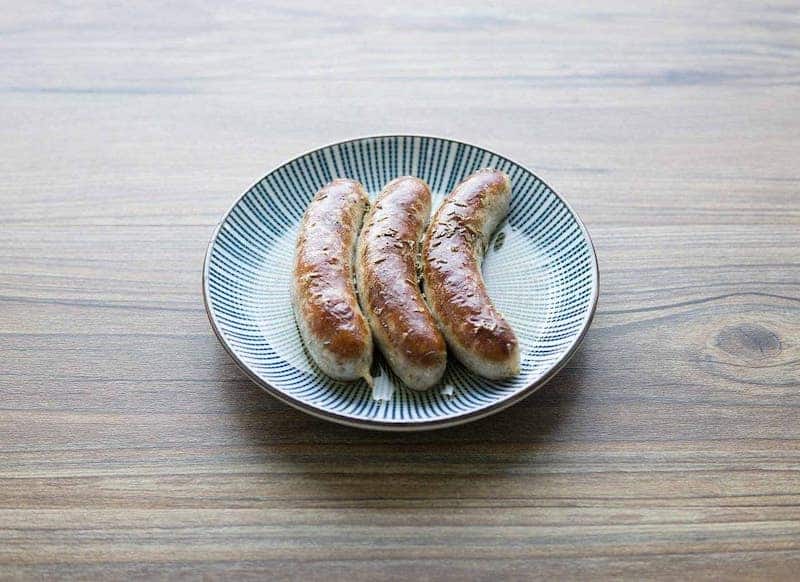Why Are Sausages Curved? (Solved!)
Whether you’re partial to Italian pork, andouille, bratwurst, turkey, or regular breakfast sausage, there’s no doubt sausages are delicious.
Typically, sausages are made from ground meat, seasonings, preservatives, and sometimes grains.
They have a recognizable texture, but what stands out is their curved shape. Why are sausages curved?
Uncooked sausages are curved because they have natural casings. These casings are usually made from animal intestines that are not straight.
Also, even straight sausages with collagen casings will curl when cooked because casings shrink from exposure to high heat.
Read on to learn more.
Why Are Sausages the Shape They Are?
When shopping for sausages, most expect them to be curved, at least slightly.
Indeed, sausages are curved, and there’s a simple explanation for their shape. It’s all about understanding sausage casings.
There are several types of sausage casings, and not all are edible, but some produce a well-known curved shape.
First, we have the natural casings made from a thin layer of the small intestine from either lamb, goat, pig, cow, or sheep.
Because the intestines meander around the animal’s abdomen, the casings already feature a natural curve.
Then, the intestines are cleaned, dried, and salted before filling. These are used for a wide range of sausage types and are entirely edible.
Synthetic casings are also widely used and made from cotton, wood pulp, or processed animal collagen. While some of them are edible, they don’t taste great and can be chewy.
Sausages with cellulose casings are typically straight, while collagen casings allow different sausage shapes, including curved ones.
Other casings include plastic, made from polymers, and plant-based, usually used with vegan sausages.
Why Does Cooking Sausages Make Them Curl?
We know why natural sausages are curved, but why do straight sausages curl when cooked?
For example, you’ve bought a package of straight-shaped breakfast sausages, but after a few minutes in the frying pan, they’ve started curling.
Of course, your first thought might be, “Is this supposed to happen?”
The answer is yes – if the sausage is curling when cooked, the casing shrinks rapidly. This is particularly true for sausages with collagen casings.
When exposed to heat, collagen dries and degrades quickly, thus molding a straight sausage into a slightly curled shape.
Another reason why cooking makes sausages curl is that some areas of a collagen casing can be thinner than others.
When the thinner part of the casing heats first, it quickly contracts and bends the sausage, creating a curved shape.
Why Are Some Sausages Curved While Others Are Not?
The casing type used for the sausage determines whether the uncooked sausage will be curved.
Manufacturers who only use natural casings can’t choose the sausage size or shape, but with synthetic and plant-based casings, options are available.
For example, collagen casings produce sausages of different sizes, shapes, and thicknesses.
The same applies to sausages with plastic casings, which can be either curved, straight, or even round.
Can You Stop Sausages From Curling?
Curling doesn’t affect the taste of the sausage. The only potential problem ensuing is sausage splitting, which can dry out the sausage and ruin the visual appeal.
But if you don’t want the straight sausage to curl at all, there are several solutions you can try to prevent it from happening.
Boil the Sausage First
If you put the sausages in boiling water for a few minutes, they’ll likely not split nor curl while cooking.
This extra step might not be the best option if you’re in a hurry, but if you’re willing to try it, it might do the trick.
Use Grill Skewers
If you have barbecue skewers, you can use them to stop sausages from curling. Be sure to properly insert the skewer to retain the sausage shape.
You might also want to use grill clamps to hold the sausage in place as it cooks. As the casings shrink, these tools help keep the sausage from curling.
Heat the Pan Evenly
If you’re frying the sausages, an evenly heated pan is the key.
If your cooking equipment allows it, ensure the pan’s heat distribution is as even as possible.
You can also try moving the sausages around to ensure they are not overcooked in some parts.
Also, try cooking the sausages on medium heat, which might go against conventional wisdom, but could help retain the sausage’s original shape.
In Summary
While some prefer the sausage shape, most are concerned about the flavor. The question of why sausages are curved has several answers.
First, natural casings are curved by default because they’re made from animal intestines.
However, collagen and plastic casings can also curve the sausages, but only if the manufacturer chooses.
Finally, some sausages will curl when cooked, but there are a few ways you can prevent that.







